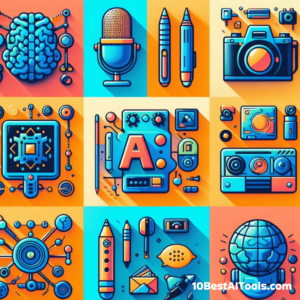AI won’t replace educators. But educators who use AI will replace those who don’t.
Let’s face it: Teaching is a labor of love—but even love needs a break. Between grading 150 essays, planning next week’s lessons, and answering 3 a.m. emails from panicked students, burnout isn’t just likely—it’s inevitable. What if you could reclaim those weekends and still inspire your students? Enter AI tools for educators: your new teaching assistants that never sleep (or demand coffee). These tools won’t replace your expertise, but they’ll handle the grunt work so you can focus on what really matters—your students. In this guide, we’ll explore 10 AI tools that automate grading,.
Comparison Table: AI Tools for Educators at a Glance
| Tool | Best For | Key Features | Pricing | Alternatives |
|---|---|---|---|---|
| Gradescope | Grading Efficiency | AI-assisted grading, rubric sharing | $1/student/year | Turnitin, Crowdmark |
| Eduaide.AI | Lesson Planning | Generates activities, worksheets, assessments | Free-$9.99/month | LessonBud, Planboard |
| Cognii | Essay Feedback | NLP-powered analysis, instant feedback | Custom Quote | Turnitin, EssayGrader |
| Quillionz | Quiz Creation | Generates quizzes from text, auto-answers | $9.99/month | Quizlet, Kahoot! |
| Knewton Alta | Adaptive Learning | Personalized assignments, real-time analytics | $44.95/course | McGraw-Hill Connect |
| Socrative | Instant Assessments | Live polls, exit tickets, auto-graded quizzes | $99/year | Mentimeter, Poll Everywhere |
| Planboard | Lesson Organization | Curriculum mapping, standards alignment | Free-$15/month | Common Curriculum |
| Turnitin | Plagiarism Detection | AI writing detection, similarity reports | $3/student/year | Grammarly, Copyscape |
| Classcraft | Student Engagement | Gamified learning, behavior tracking | $12/month | ClassDojo, Kahoot! |
| Edpuzzle | Video Lessons | Interactive video quizzes, progress tracking | $11.50/month | PlayPosit, Nearpod |
Detailed Breakdown of All 10 Tools
1. Gradescope
- Pros: Cuts grading time by 70%, especially for STEM; rubrics ensure consistency.
- Cons: Steep learning curve for non-techy teachers.
- Pricing: $1/student/year (discounts for institutions).
- Integration: LMS platforms like Canvas, Blackboard.
- Use Case: A college professor grading 300 calculus exams in one evening.
2. Eduaide.AI
- Pros: Generates lesson plans in seconds; aligns with Common Core standards.
- Cons: Limited customization in the free tier.
- Pricing: Free (basic) to $9.99/month (Pro).
- Accuracy: 90% relevance in generated content.
- Use Case: A middle school teacher creating a WWII unit plan during lunch break.
3. Cognii
- Pros: Provides detailed essay feedback (grammar, coherence); reduces grading bias.
- Cons: Expensive for individual teachers.
- Pricing: Custom (school-wide licenses).
- Integration: Works with Moodle, Google Classroom.
- Use Case: A high school English teacher offering instant feedback on thesis statements.
4. Quillionz
- Pros: Turns textbook chapters into quizzes in 2 clicks; great for last-minute reviews.
- Cons: Struggles with complex/open-ended questions.
- Pricing: $9.99/month (Premium).
- Use Case: A biology teacher prepping a midterm review game overnight.
5. Knewton Alta
- Pros: Adapts to student skill gaps; auto-generates practice problems.
- Cons: Limited to college-level STEM courses.
- Pricing: $44.95 per student/course.
- Integration: LTI-compatible with most LMS platforms.
- Use Case: A community college instructor personalizing homework for struggling students.
6. Socrative
- Pros: Real-time quiz results; perfect for bell-ringers or exit tickets.
- Cons: No AI-driven insights—basic analytics only.
- Pricing: $99/year (Pro).
- Use Case: A 5th-grade teacher assessing fractions mastery in real time.
7. Planboard
- Pros: Drag-and-drop lesson scheduling; syncs with school calendars.
- Cons: No AI-generated content—strictly organizational.
- Pricing: Free (basic) to $15/month (premium).
- Use Case: A substitute teacher seamlessly taking over a maternity leave schedule.
8. Turnitin
- Pros: Flags AI-written essays (like ChatGPT); detailed originality reports.
- Cons: Controversial “false positive” accusations.
- Pricing: ~$3/student/year (volume discounts).
- Use Case: A university professor ensuring academic integrity in research papers.
9. Classcraft
- Pros: Turns classroom management into an RPG; boosts participation.
- Cons: Time-consuming to set up quests/rewards.
- Pricing: $12/month (Teacher Premium).
- Use Case: A 6th-grade teacher reducing disruptions through gamified behavior tracking.
10. Edpuzzle
- Pros: Adds quizzes to YouTube videos; tracks who actually watched.
- Cons: Limited video length on the free plan.
- Pricing: $11.50/month (Pro).
- Use Case: A flipped classroom teacher ensuring homework engagement.
How to Choose the Right AI Tool
Ask yourself:
- Pain Points: Grading overload? Try Gradescope. Lesson-planning dread? Eduaide.AI.
- Budget: Free tools like Eduaide.AI’s basic tier vs. institutional licenses for Cognii.
- Class Type: K-5? Classcraft. College STEM? Knewton Alta.
- Tech Comfort: Drag-and-drop (Planboard) vs. NLP algorithms (Cognii).
Pro Tips for Maximizing AI Tools for Educators
- Layer Tools: Use Eduaide.AI for lesson drafts + Planboard for scheduling.
- Spot-Check AI: Scan 10% of AI-graded essays (Cognii) to ensure fairness.
- Student Input: Let kids design Classcraft quests—they’ll buy into the system faster.
Ethical Considerations
- Bias: AI like Cognii might favor certain writing styles. Audit feedback for cultural sensitivity.
- Privacy: Ensure tools like Edpuzzle comply with FERPA for student data.
- Transparency: Tell students when AI is grading them—no one likes a robot surprise.
The Future of AI in Education
Imagine AI tutors that adapt to a student’s learning trauma or VR field trips auto-generated from history lessons. By 2030, AI could diagnose dyslexia in 10 minutes or predict dropouts before they happen. The educators who thrive will use AI not to replace empathy but to amplify it.
Conclusion
AI isn’t here to take your desk—it’s here to take the paperwork off your desk. Whether you’re drowning in grading or creatively burnt out, there’s a tool here to hand you a lifeline. Start small: Try Quillionz for a quiz or Eduaide.AI for tomorrow’s lesson. And remember, the best classrooms blend tech efficiency with human magic.
Check Out: Best AI Tools For content Creators
FAQs for AI Tools for Educators
Q: “Can AI really grade essays as well as humans?”
A: For grammar/rubrics? Yes. For creativity/tone? Not yet—always review critical assignments.
Q: “Are there free AI tools for educators?”
A: Yes! Eduaide.AI, Planboard, and Socrative have solid free tiers.
Q: “How do I protect student data with these tools?”
A: Stick to GDPR/FERPA-compliant tools (Turnitin, Edpuzzle) and avoid storing data locally.
Q: “Will AI make teachers obsolete?”
A: Absolutely not. AI can’t host a poetry slam, mediate a playground conflict, or spark a lifelong passion. You’re irreplaceable.
Follow 10 Best AI Tools on LinkedIn for more









